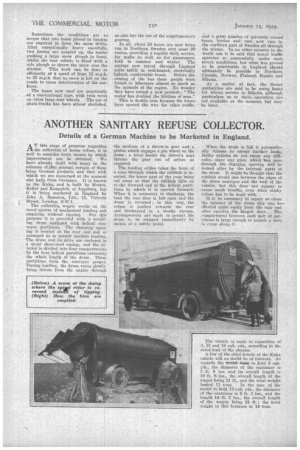BUS RUNNING IN THE ARCTIC CIRCLE.
Page 27

Page 28

If you've noticed an error in this article please click here to report it so we can fix it.
The Use Of Special Types of Vehicle Makes it Possible to Maintain Allthe-year-round Services in Spite of Severe Winter Conditions.
VEN 1n thiS eoullti3','plirUA ticularlY the Highlands; • the problem of keePing the 'rOads open • in ,--Winterfor. -Motorbus Operation is some-: lines an acute one, but how • ; Much more difficult must such problem be in the extreme 7 uorth of Sweden.' Yet in these ditettrY -••Aretie ' wastes bites nOt only itut freely bil the year round, but the vehicles themselves tire utilizedfor the reMova12of the greater parr of
• the snew, from the roads . Sweden is a rectangular The southern part Alai :001y; the same climate as that of this country, but the northern part, extending inside the Arctic Circle, endures the most severe climatic conditions. Deep snow and a very low temperature last for more than six months of the year.
Up to but five years ago virtually all winter transport in his part of the world was performed i•y horses or reindeer. Movement. therefore, was greatly restricted during the winter months, the system of clearing the snow from the roads at that thne by means of horse-drawn ploughs being most primitive. It required much effort to keep the highways open sufficiently to permit of the passage of oneway traffic ; there were no ways of IT-. moving the high walls of snow that were piled up on each side, whilst, because a considerable amount of snow was always left on the surface, the roads deteriorated rapidly.
About five years ago the Swedish postal authorities inaugurated regular motorbus services throughout the northern part of the country, not only near the coast of the Gulf of Bothnia but deep into the interior of Lapland.
These buses were designed to carry both passengers and mails in the winter as well as in the summer, and were made in the country by Aktiebolaget ScaniaVabis, Sodertalje.
To obtain an idea as to the stress to which these buses are subjected during winter operation, it need only be stated that, on some days, they have to TIM from 12 hours to 15 hours on lowest _gear with virtually full load on the engine. Small wonder, then, that the oil in the gearbox sometimes becomes very hot, although the actual temperature may be as low as 20 degrees or 30 degrees below zero.
The buses first used were equipped with an auxiliary gear in the rear axle, as well as with the ordinary gearbox giving four speeds, so that eight different gear ratios could be obtained.
The front wheels were equipped with skis and the rear wheels with a special type of chain-track with a wide rubber belt passing around the wheels and two pairs of subsidiary wheels. This equipment was easily detachable when not required. Snow ploughs were also carried. The vehicles themselves were used solely for carrying passengers, mails being accommodated on trailers, which in the winter ran on skis.
As it was found that these vehicles were not powerful enough to keep the roads clear, larger lorries and buses, made by the same firm, were introduced. These were 3-tonners equipped so that snow ploughs could be fitted either in front or at the side. As a result of the use of these vehicles the majority of the main roads of Northern Sweden are now kept open through the winter.
Sometimes the conditions are so severe that two buses placed in tandem are required to force the snow. drifts. After exceptionally heavy snowfalls, two lorries are coupled up, the leader pushing a large snow plough in front, whilst the rear vehicle is fitted with a side plough to throwthe snow over the ditches. This work can be done so efficiently at a speed of from 15 m.p.h. to 25 m.p.h. that no snow is left on the roads to cause deterioration of the surfaces.
The buses now used are practically of a conventional type, with twin tyres on extra large rear wheels. The use Of chain-tracks has been almost abolished, as also has the use of the supplementary gearing.
In all, about 50 buses are now being run in Northern Sweden over some 20 routes, providing a regular daily service, for mails as well as for Passengers, both in summer and winter. The natives now travel through Lapland quite safely in well-heated, electrically
lighted, comfortable buses. Before the . coming of the bus these people were forced to hibernate almost as much as the animals of the region. No wonder they have coined a new proverb: "The motor has doubled the lifetime of man." This is doubly true because the buses, have opened the way for other traffic,
and a great number of privately owned buses, lorries and cars now run in the northern part of Sweden all through the winter. In no other country in the world can it be said that motor traffic operates so .successfully under such severe conditions, but what has proved to be practicable in Lapland should ultimately be possible in Northern Canada, Norway, Finland, Russia and Siberia.
As a matter of fact, the Soviet authorities are said to be using buses for winter service in Siberia, although particulars as , to their.: 'operation are not available at the moment, but may be later.
































